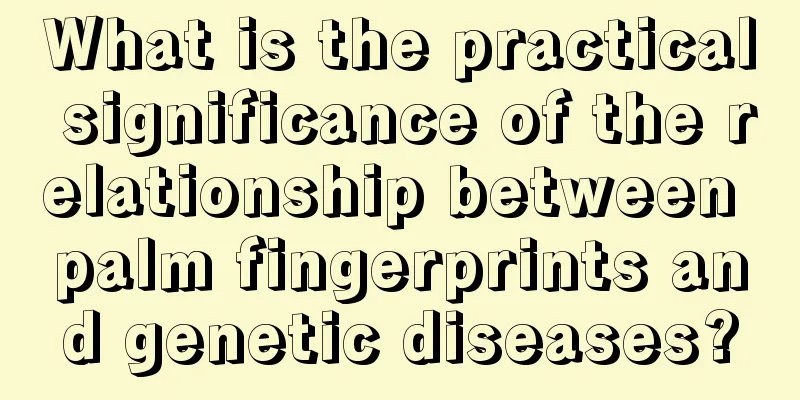What is the practical significance of the relationship between palm fingerprints and genetic diseases?

|
The lines on the palm are also called dermatoglyphics. This is a basic biological characteristic that everyone has. The lines on the palm make people's hands more powerful and allow them to grab smooth objects at will without dropping them. Palm fingerprints are a more widely used area. In modern life, people have conducted in-depth research on palm fingerprints. Let’s take a look at the relationship between palm fingerprints and genetic diseases and what practical significance it has. Dermatoglyphic analysis is an auxiliary means of medical diagnosis of genetic diseases, with unique advantages: simple, fast, economical, harmless to people, especially after the baby is born before other clinical manifestations appear. Dermatoglyphic analysis 1: Fingerprint shape Fingerprints are divided into three types according to the presence and number of tridents on the outer side of the fingertips: arch pattern, dustpan pattern and bucket pattern. The so-called trigeminal fingerprint refers to three groups of ridges with different directions converging together to form a "Y" or "human" shape. The arched pattern runs from one side to the other with parallel ridges, with a bow-shaped bulge in the middle and no tridents. The dustpan-shaped pattern, commonly known as a winnowing dustpan, has lines that start from one side, bend upward obliquely, and then return to the original side, shaped like a winnowing dustpan. There is a trident on the lower side of the dustpan. If the opening of the dustpan faces the ulnar side of the hand, it is called a cuneiform dustpan or a straight dustpan; if the opening of the dustpan faces the radial side of the hand, it is called a radial dustpan or a reverse dustpan. The ridges of the bucket-shaped pattern are in the shape of concentric circles, spirals or hyperbolas, with two tridents. They can be specifically divided into ring-shaped patterns, spiral patterns and twisted patterns. Normal people have certain frequencies of occurrence of various fingerprint patterns, as shown in the following table: As can be seen from the above table, the fingerprints of normal people's hands are mostly in the shape of a positive scoop and a bucket, while bow-shaped and reverse scoop are rare. However, the incidence of fingerprints in patients with genetic diseases is abnormal. For example, in the normal population, the incidence of inversion of the 4th and 5th fingers is only 0-1%, while in patients with congenital idiocy, inversion is more common. The total number of arch-shaped fingerprints on both hands is greater than 7, which is only about 1% in the normal population, but as high as 80% in patients with trisomy 18. The total number of bucket-shaped fingerprints on both hands is greater than 8, which is only 8% in the normal population, but reaches 32% in 5P- patients. The above cases are dermatoglyphic changes in patients with chromosomal diseases. |
<<: Early symptoms of delayed splenic rupture
Recommend
The ten most likely factors to cause liver cancer
In recent years, liver cancer has become a major ...
How to treat dental fluorosis?
Everyone wants white and bright teeth, especially...
Is nebulization good for nasopharyngeal cancer? What should I pay attention to in my diet?
Nowadays, many patients are concerned about the c...
What are the symptoms of advanced liver cancer? 4 symptoms of advanced liver cancer
Pain in the liver area is the first symptom of li...
What is the reason for cold back and fear of cold
Traditional Chinese medicine believes that, as fa...
72Can gastric cancer and cerebral infarction be treated surgically?
Generally speaking, if the patient is in good phy...
How long is the life expectancy of prostate cancer
As long as it is a malignant tumor, the survival ...
What are the effects and functions of Ligustrum lucidum
There are many names for the fruit of Ligustrum l...
Which hospital is good for treating fibroids
Which hospital is good for the professional treat...
How to avoid infection with tampons
Internal tampons have always been loved by profes...
Bones grow in the heart of the hand
If there is a problem with a person's hands, ...
What are the symptoms of chronic hepatitis?
Hepatitis is divided into acute hepatitis and chr...
Pigeon breast plastic surgery correction method
Pectus carinatum refers to a deformity in which t...
How much does it cost to treat pancreatic cancer
How much does it cost to treat pancreatic cancer?...
Silver Flower Vine Face Wash
Many elderly people like to use plants to make so...









